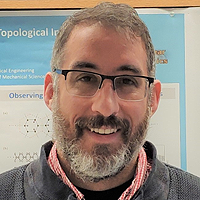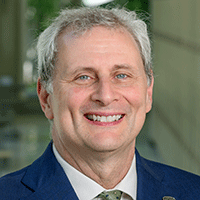
Wednesday, September 11 | 8:00AM – 9:00AM | Buckhead A, Conference Center Level
Michael J. Leamy
George W. Woodruff School of Mechanical Engineering
Atlanta, Georgia, USA
Keynote Title: Reconfigurable Topological Insulators and Experimentally-Demonstrated Applications Using an Electroacoustic Material Platform
Abstract: Topological insulators (TIs), exhibiting topologically-protected edge and interface waves, have recently emerged in phononic systems. Reconfigurabilty is essential for enabling TI-based applications. One potential means for achieving reconfigurability employs shunted piezoelectric (PZT) disks in which a unit cell’s mechanical impedance is altered using negative capacitance circuits. Dynamic reconfigurability and programmability of such material platforms can then be obtained through simple on/off switching. In this vein, we propose and experimentally verify an electroacoustic TI which exhibits programmable topologically protected edge states useful for acoustic multiplexers, demultiplexers, and transistors. This reconfigurable structure is composed of an elastic hexagonal lattice whose unit cell contains two shunted PZT disks, each connected to a negative capacitance circuit by an on/off switch. Closing one or the other circuit results in the breaking of mirror symmetry and yields mechanical behavior analogous to the quantum valley Hall effect. By interfacing two topologically-distinct materials, a domain wall is introduced exhibiting a localized interface state topologically-protected from backscattering at defects and sharp edges. Through the use of programmable time-division, in which domain walls appear and disappear in time, we demonstrate multiplexing and demultiplexing. We also demonstrate an acoustic transistor using the same programmable platform, before closing with a discussion on future research directions.
Biography: Michael J. Leamy joined the George Woodruff School of Mechanical Engineering, Georgia Tech, as an Assistant Professor in August, 2007. He then served as an Associate Professor (2012-2018), Professor (2018-Present), and Director of Graduate Studies (2023-Present). Dr. Leamy received his B.S. (1993) from Clarkson University, and his M.S. (1995) and Ph.D. (1998) from The University of Michigan, Ann Arbor, all in Mechanical Engineering. Prior to his position at Georgia Tech, Professor Leamy worked as an Assistant Professor at the United States Military Academy (West Point, NY), a Research Scientist at the MITRE Corporation (McLean, VA), a Research Associate at the NASA Langley Research Center (Hampton, VA), and a Postdoctoral Fellow at Israel’s Institute of Technology (Technion). Dr. Leamy’s research interests are in emerging and multidisciplinary areas of engineering science, with an emphasis on nonlinear dynamical behavior in structures, materials, and complex systems. Emerging engineering systems of particular interest include acoustic metastructures, topological insulators, and electric vehicle powertrains. He has received the Distinguished Achievement Award (1998) from the University of Michigan, a Koret Foundation Fellowship (1998) from the Technion, the Army’s Superior Civilian Service Award (2003), the Lockheed Dean’s Excellence in Teaching Award (2010), and the Lloyd Hamilton Donnell Best Paper Award from Applied Mechanics Reviews (co-recipient, 2016). In addition, he was named a Fellow by ASME (2014), and a Woodruff Faculty Fellow (2017) by the George Woodruff School of Mechanical Engineering. His past and current editorial positions include serving as an Associate Editor for the Journal of Vibration and Acoustics (2011-2017), Nonlinear Dynamics (2019-2023), Wave Motion (2017-Present), and Applied Mechanics Reviews (2018-Present). He is presently the Specialty Chief Editor, Acoustic Metamaterials, for Frontiers in Acoustics. Dr. Leamy's research program has been supported by the Ford Motor Corporation, General Motors, Honeywell Inc., Ferrari S.p.A., ThyssenKrupp Elevator America, the National Science Foundation, the Department of Energy, the Defense Threat Reduction Agency, the Army Research Office, and the Office of Naval Research. He has authored or co-authored over 250 peer-reviewed publications.

Monday September 9 | 8:00 AM – 9:00 AM | Buckhead A, Conference Center Level
Paolo Ermanni
ETH Zurich
Dept. of Mechanical & Process Engineering
Laboratory for Composite Materials and Adaptive Structures (CMASLab)
Keynote Title: Lightweight Adaptive Systems: From Heart to Space!
Abstract: Exceptional specific stiffness and strength, combination of anisotropic properties and multilayer arrangement make fiber-reinforced polymers (FRP) the ideal material for high performance lightweight structures. Material parameters can be adjusted at different length scales, which results in a vast design space, thus enabling the realization of load-carrying structural systems with amazing structural features, including extreme shape deformation and reconfigurability. The talk presents and discusses structural concepts, actuation mechanisms, and applications studied in recent years at the Laboratory of Composite Materials and Adaptive Structures (CMASLAb). Shape adaptation is achieved through inner compliance, passive and semi-active variable stiffness approaches. Selective elastic instability and integration of multi-stable elements provide additional mechanisms to induce nonlinear variable stiffness response and therefore achieve controlled deformability in load-carrying lightweight structures. The integration of FRPs elements into mechanical metamaterials is further expanding the potential of composite materials for multi-functional lightweight applications, by adding additional geometrical parameters and tunability of the repeating unit cell. A promising concept is relying on FRP shell metastructures consisting of a thin FRP-frame and a pre-stretched soft polymer membrane. The instability of the initially flat component is inducing a rich multi-stable behavior, being a first step towards the realization of programmable structures, which can morph to multiple 3D shapes from an initial flat configuration upon an external stimulus. Finally, we are currently exploring the mechanical behavior and the potential of very thin composite shells made from continuously fiber reinforced Polyether ether ketone (PEEK). Those composite materials are capable of withstanding large bending curvatures without failure and are therefore pre-destined for applications, which require a high degree of deformability for shape adaptation and deployment purposes. Applicability of thin fiber reinforced PEEK shells in selected biomedical and space systems will be discussed.
Biography: Paolo Ermanni, born June 15th, 1959, from Bissone (TI), has been Professor of Composite Materials and Adaptive Structures, ETH Zurich, Department of Mechanical and Process Engineering since April 1st, 1998 (Associate Professor until March 2003 and Full Professor thereafter). He studied Mechanical Engineering at ETH Zurich and received his Doctoral degree from ETH in 1990 for his Dissertation on novel process technologies for highly integrated Composites fuselage structures. He spent more than five years at Airbus Germany, Hamburg as a senior engineer and later, as a project manager. In 1997 he took on a new challenge as a manager in the strategic consulting firm A.T. Kearney, Milan.
Ermanni's research is concerned with the exploration of innovative designs, material architectures and advanced processing technologies of high-performance composite structures. He is particularly interested in problems related to adaptive structures for stiffness and shape control for aerospace and biomedical applications.

Tuesday, September 10 | 8:00AM – 9:00AM | Buckhead A, Conference Center Level
Donald Leo
Executive Vice President and Provost
Ohio University
Athens, OH
Keynote Title: Smart Materials and Adaptive Systems: How Far Have We Come, and How Far Do We Have to Go?
Abstract: The field of smart materials has been a sustained field of scholarship for over forty years. The roots of the field lie in the desire to make engineered systems sense and react to environmental stimuli in a manner that mimics the abilities of natural systems. The field has made significant advances over these 40+ years, for example, in the development of a variety of stimuli-responsive materials; advancing the integration of control systems with engineered systems, and the use of advanced computing architectures to create "intelligent" engineered systems that respond to external stimuli. This talk will explore the early motivations for the field and relate these advances to the ways in which our field has influenced society, and it will also highlight ways in which the field of smart materials and adaptive systems may influence society in the future.
Biography: Don Leo is currently the Executive Vice President and Provost at Ohio University, an R1 public university in Athens, OH, that enrolls over 28,000 students in over 250 degree programs. Prior to his appointment at Ohio University, Don served as the Dean of the College of Engineering at the University of Georgia, where he worked with faculty, staff, and students to grow the enrollment, research, and service of the college over an eleven-year period. From 1998-2013 he was a faculty member at Virginia Tech, where he did a majority of his research in the field of smart materials, focusing primarily on the integration of control theory, material science, and vibrations to understand how smart material systems could improve engineered systems. He received his Bachelor of Science in Aeronautics and Astronautics Engineering from the University of Illinois, Urbana-Champaign, and his Master of Science and Doctor of Philosophy degrees in Mechanical and Aerospace Engineering from the University at Buffalo under the director of Dr. Daniel Inman. He authored the textbook Engineering Analysis of Smart Materials Systems (for which he still receives a small royalty check twice a year) is a Fellow of ASME and has been awarded the Alumni of the Year Award and Young Alumnus Award from UIUC Department of Aerospace Engineering.